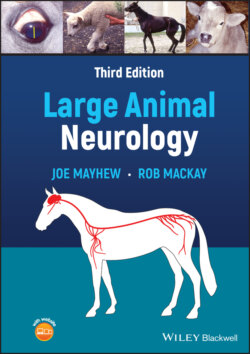Читать книгу Large Animal Neurology - Joe Mayhew - Страница 37
Oculomotor nerve—CN III; trochlear nerve—CN IV; abducens nerve—CN VI
ОглавлениеIn addition to parasympathetic innervation of the pupillary constrictor smooth muscles, the oculomotor nerve also innervates the somatic extraocular muscles, along with the trochlear and abducens nerves. The function of these muscles and nerves is tested by observing the normal position of the eyes within the bony orbits and by observing eye movement. An abnormal eye position or strabismus results when these nerves or muscles are damaged. Physical deformity of the bony orbit and prominent, particularly congenital, blindness all can result in degrees of abnormal eye position.
When evaluating eye position and movement, consideration must be given to the normal response of the eyes to head posture and movement. When the nose of a large animal is elevated to extend the head, the eyes tend to maintain a horizontal axis and thus move ventrally in the bony orbits. As the head is moved to one side, the eyes move in a rhythmical manner until head movement stops. There is slow phase movement in the direction opposite to the direction of head movement, followed by a fast (catch‐up) phase in the direction of head movement. These eye movements are regarded as physiologic vestibular nystagmus and result from the connection from the vestibular apparatus in the inner ear and the medullary vestibular nuclei to the nuclei of the cranial nerves controlling eye movement, CNs III, IV and VI. Normal inducible vestibular nystagmus thus requires an intact vestibular system, intact cranial nerves III, IV, and VI, and the connections between all of these in the medial longitudinal fasciculus.
The forms of strabismus described for paralysis of each of these cranial nerves should be present in all positions of the head. Such examples of true strabismus are not often encountered in large animals. Mydriasis is seen with oculomotor nerve disease, and a tendency for lateral eyeball deviation has been observed in horses with midbrain lesions presumably involving the oculomotor nuclei. The dorsomedial, rotational positioning of the eyeball seen in many diffuse brain diseases in ruminants such as polioencephalomalacia and meningitis has been ascribed to the involvement of the trochlear cranial nerve IV. This may not however be due to a true trochlear paralysis as the eyeballs can be moved from this position by moving the head, suggesting that the dorsal oblique muscle and CN IV are functional. What is most frequently seen in large animals is a deviation of the eyeballs resulting from a disturbance of the vestibular system that alters the normal tonic mechanism controlling eye position. This strabismus is usually ipsilateral to the vestibular lesion and most often is ventral, but may be medial. The important difference is that the eyeballs can be moved out of this position. Periorbital lesions, particularly those of trauma and neoplasia, often result in mechanical eye deviations. The eyeball position of newborn foals often is rotated ventromedially relative to that of adult horses.18 Also, animals that are congenitally blind may have abnormal eyeball positioning and movement.
By observing the corneal reflex, one can assess sensation from the cornea in the ophthalmic branch of the trigeminal nerve (see below) and the ability to retract the eyeball. The latter is purportedly mediated by just the retractor oculi muscle innervated by the abducens nerve CN VI. However, full eyeball retraction in large animals may require full function of all extraocular muscles innervated by CNs III, IV and VI to be effective. This reflex can be usefully tested by pressing on the closed eyelids while palpating for reflex eyeball retraction, thereby avoiding potential corneal damage.
